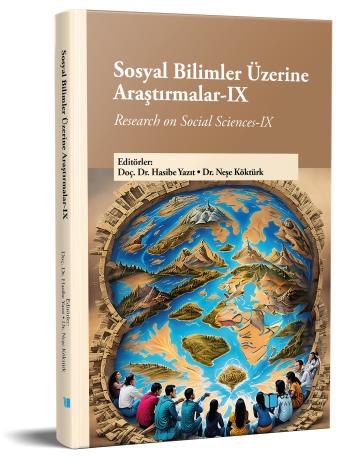
Konya Doğanhisar Deştiğin Ulu Camii ve Kalem İşi Bezemeleri
Şu kitabın bölümü:
Yazıt,
H.
&
Köktürk,
N.
(eds.)
2023.
Sosyal Bilimler Üzerine Araştırmalar-IX.
Özet
Deştiğin, Konya’nın Doğanhisar ilçesine on beş km. uzaklıkta bir yerleşim birimidir. Deştiğin’in merkezinde bulunan Ulu Camii, moloz taş ve ahşap hatıllarla inşa edilmiş, kareye yakın planlı, girişi ve son cemaat yeri doğuda bulunan, kuzey güney doğrultusunda, üç nefli bir yapıdır. Sade mimarisine karşın kırmızı, mavi, yeşil ve sarı renklerle boyanmış zengin kalem işi bezemelere sahiptir. Yapım yılı bilinmeyen yapının kalem işleri 1287 (M. 1870/71) tarihlidir. Son cemaat yerinin güney duvarında ve harim duvarlarında bulunan bezemeler geçirdikleri onarımlarda niteliklerini kaybetseler de yapıyı değerli kılarlar. Duvar yüzeyleri yatay olarak dörde bölünmüş, yukarıda kalan üç birimlik bölüm bezeme alanı olarak kullanılmıştır. Kıvrık dallar üzerine yerleştirilmiş bitkisel bezemeler, meyveli- meyvesiz ağaçlar, caminin içinde neşeli ve canlı bir bahçe yaratırlar. Nakışların arasına, “yelkenli gemi”, “tek kubbeli dört minareli cami”, “tac-ı şerif”, “teber”, “mızrak”, “topuz” gibi tekke sembolleri, “çark-ı felek”, “yılan”, “Âlem-i Lâhût”, kırmızı meyveli ağaç”, “ay-yıldız”, “tekli ve üçlü kandil”, “saat”, “peşkir” motifleri yerleştirilmiştir. Duvarlarda tüm camilerde görülebilecek bir yazı programı kullanılmış, güney duvarına iki adet simetrik düzenlenmiş, “Ali” ismi yazılmıştır. Çalışmada bezeme elemanları tanımlanmış, kullanılan tekke sembolleri de göz önüne alınarak motiflerin yüklenmiş olabilecekleri anlamlar araştırılmıştır. Bezemeleri yapan kalem işi usta ya da ustaların mensup olabileceği tasavvuf ekolleri irdelenmiş, bezemelere kaynaklık eden görsel kaynaklar tespit edilmeye çalışılmıştır. Kalem işi bezemelerin benzerleri Deştiğin kasabasının yirmi km. uzağındaki Hüyük ilçesinin Çavuş köyü camiinde bulunur. Gezici derviş ustaların eserleri olan bu yapılar 19. yüzyılın ikinci yarısında Konya’nın Göller bölgesinin kırsal alanındaki sanatsal faaliyetlerle ilgili önemli veriler sağlarlar.

